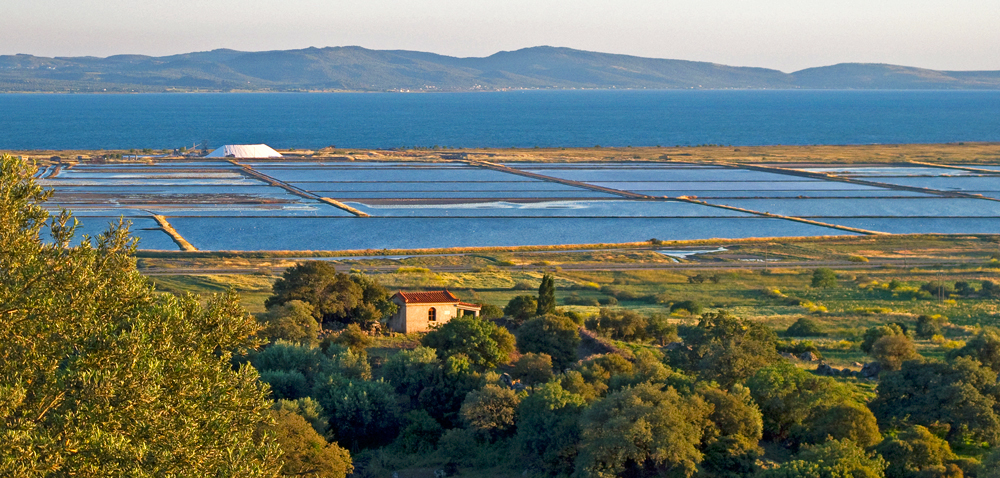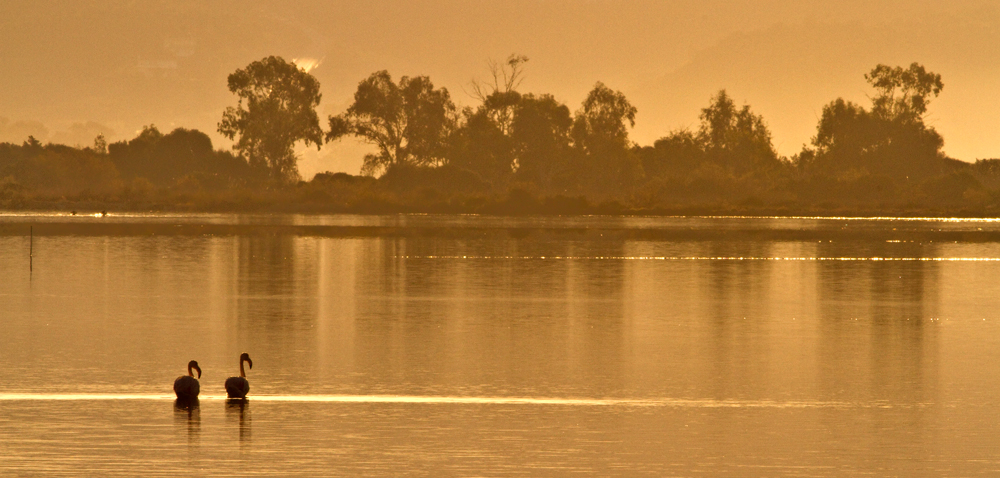Wetlands
Kolovrechtis

A small wetland of Evia that, despite the constant
pressures, still attracts dozens of species of birdlife, especially
during migrations. Kolovrechtis is a coastal wetland located a few
kilometers north of Chalcis, very close to the town of Psachna.
Typically it is called wetland or marsh of Psachna and Livadi
(grassland). However, the name Kolovrechtis (translated as wet butt) has
more popular value, as it shows that people here did the namesake kind
of fishing that requires pulling large nets from the shallows and
therefore get fishermen wet. The wetland spreads in an area of 1 sq.km.,
that is about half of the previous physical extent of the wetland. In
the west it ends at the North Euboean gulf, to the north is separated
from the crops of the area through small channels and streams and to the
east and south is bounded by small hills. The largest section of the
wetland consists of a fresh water marsh created by a small stream coming
from the plain of Psachna and from underground springs. Closer to the
sea the waters become brackish, while near the mouth of the river a fish
farm has been created. Although relatively small in size, Kolovrechtis
gathers many interesting habitat elements, such as wet grasslands,
reeds, saltwater marshes, sandy islets, salt flats, shallow sandy
seabeds, maquis hills, etc. It is important that in Voleri location near
the wetland is an eminent site of the Paleolithic era. The region was a
magnet to the first people because there is an abundance of flint
rocks, one of the first materials used in the manufacture of stone
tools. Kolovrechtis is a striking example of mismanagement that
characterises many small wetlands in Greece. The degradation is
continuous and involves casting industrial and urban waste, burning the
reeds for the extension of corps, and small landfills. There is also
great disturbance from the main road of central Evia, which passes
through the core of the wetland. With all this, it’s almost a miracle
that Kolovrechtis still attracts so many species of wildlife.
The vegetation in the area consists mainly of stout grass (Phragmites australis) and sedges (Carex divisa, Carex extensa, Carex hispida, Juncus bufonius, Juncus maritimus) alternating with halophytes (Arthrocnemum macrostachyum, Halimione portulacoides, Salsola soda, Sarcococcus fruticosa, Scirpoides holoschoenus) from the sea side. The surrounding hills are covered with typical Mediterranean vegetation with lentiscs, wild olive trees, turpentine trees, evergreen oaks, oleanders, weaver’s brooms, thymes, oreganos, jointfirs, jerusalem sages, wild asparagus, asphodels, rockroses and few aleppo pines. The most important plants in the area are Alyssum euboeum, Bupleurum euboeum, Buglossoides tenuiflora and Silene squamigera subsp. squamigera. Other interesting species are Leontice leontopetalum subsp. leontopetalum, Dichoropetalum vittijugum, Lemna minor, Aristolochia rotunda subsp. rotunda, Carduus nutans subsp. scabrisquamus, Echinops graecus, Leptoplax emarginata, Centaurea calcitrapa, Agrostemma githago subsp. githago, Minuartia globulosa, Petrorhagia armerioides, Silene remotiflora, Colchicum cupanii subsp. cupanii, Convolvulus dorycnium, Medicago doliata, Ornithogalum atticum, Crocus laevigatus and Iris tuberosus. Flora includes also species such as Acanthus spinosus, Allium staticiforme, Sternbergia lutea, Crithmum maritimum, Anacyclus clavatus, Atractylis cancellata, Carlina lanata, Centaurea solstitialis subsp. solstitialis, Geropogon hybridus, Onopordum illyricum subsp. cardunculus, Tragopogon porrifolius subsp. eriospermus, Tripolium pannonicum subsp. pannonicum, Anchusa undulata subsp. hybrida, Echium plantagineum, Symphytum bulbosum, Cakile maritima subsp. maritima, Matthiola tricuspidata, Silene nocturna, Spergularia salina, Astragalus pelecinus, Drimia maritima, Lamium bifidum subsp. bifidum, Prunella laciniata, Limonium bellidifolium, Cyclamen graecum subsp. graecum and Ranunculus chius. The orchids here are Anacamptis pyramidalis, Anacamptis papilionacea, Himantoglossum robertianum, Neotinea tridentata, Orchis italica, Serapias bergonii, Serapias vomeracea, Ophrys lutea, Ophrys aesculapii, Ophrys mammosa and Ophrys tenthredinifera.
The vegetation in the area consists mainly of stout grass (Phragmites australis) and sedges (Carex divisa, Carex extensa, Carex hispida, Juncus bufonius, Juncus maritimus) alternating with halophytes (Arthrocnemum macrostachyum, Halimione portulacoides, Salsola soda, Sarcococcus fruticosa, Scirpoides holoschoenus) from the sea side. The surrounding hills are covered with typical Mediterranean vegetation with lentiscs, wild olive trees, turpentine trees, evergreen oaks, oleanders, weaver’s brooms, thymes, oreganos, jointfirs, jerusalem sages, wild asparagus, asphodels, rockroses and few aleppo pines. The most important plants in the area are Alyssum euboeum, Bupleurum euboeum, Buglossoides tenuiflora and Silene squamigera subsp. squamigera. Other interesting species are Leontice leontopetalum subsp. leontopetalum, Dichoropetalum vittijugum, Lemna minor, Aristolochia rotunda subsp. rotunda, Carduus nutans subsp. scabrisquamus, Echinops graecus, Leptoplax emarginata, Centaurea calcitrapa, Agrostemma githago subsp. githago, Minuartia globulosa, Petrorhagia armerioides, Silene remotiflora, Colchicum cupanii subsp. cupanii, Convolvulus dorycnium, Medicago doliata, Ornithogalum atticum, Crocus laevigatus and Iris tuberosus. Flora includes also species such as Acanthus spinosus, Allium staticiforme, Sternbergia lutea, Crithmum maritimum, Anacyclus clavatus, Atractylis cancellata, Carlina lanata, Centaurea solstitialis subsp. solstitialis, Geropogon hybridus, Onopordum illyricum subsp. cardunculus, Tragopogon porrifolius subsp. eriospermus, Tripolium pannonicum subsp. pannonicum, Anchusa undulata subsp. hybrida, Echium plantagineum, Symphytum bulbosum, Cakile maritima subsp. maritima, Matthiola tricuspidata, Silene nocturna, Spergularia salina, Astragalus pelecinus, Drimia maritima, Lamium bifidum subsp. bifidum, Prunella laciniata, Limonium bellidifolium, Cyclamen graecum subsp. graecum and Ranunculus chius. The orchids here are Anacamptis pyramidalis, Anacamptis papilionacea, Himantoglossum robertianum, Neotinea tridentata, Orchis italica, Serapias bergonii, Serapias vomeracea, Ophrys lutea, Ophrys aesculapii, Ophrys mammosa and Ophrys tenthredinifera.
At the top of the birds using the wetland as a
migration station are glossy ibises and lapwings. From the predators
stands out the occasional presence of ospreys, followed by species such
as marsh harriers, Montagu’s harriers, common buzzards, sparrowhawks,
kestrels, lesser kestrels, peregrines and red-footed falcons. Little owl
and scops owl are the night predators in the area. Wetland birds
include black-necked grebes, cormorants, little bitterns, squacco
herons, grey herons, great egrets, little egrets, shelducks, mallards,
pintails, teals, water rails, coots, moorhens, black-winged stilts,
little ringed plovers, kentish plovers, grey plovers, dunlins, little
stints, common sandpipers, wood sandpipers, redshanks, greenshanks,
curlews, ruffs and snipes. The sandy islets gather large shoals of gulls
and terns, like black-headed gulls, slender-billed gulls, mediterranean
gulls, yellow-legged gulls, little gulls, sandwich terns, little terns,
common terns and black terns. Other birds of the area are turtle doves,
nightjars, swifts, hoopoes, kingfishers, crested larks, swallows, house
martins, water pipits, red-throated pipits, wrens, black redstarts,
northern wheatears, whinchats, stonechats, song thrushes, blackcaps,
sardinian warblers, sedge warblers, fantail warblers, willow warblers,
woodchat shrikes, starling, linnets, goldfinches, greenfinches, serins,
reed buntings and corn buntings.
Green toads, tree frogs and balkan frogs are the only amphibians of Kolovrechtis. The reptiles includes species such balkan pond turtles, marginated tortoises, Hermann’s tortoises, glass lizards, mediterranean house geckos, balkan green lizards, Erhard’s wall lizards, snake-eyed skinks, ocellated skinks, worm snakes, large whip snakes, four-lined snakes, balkan whip snakes, levant montpellier snakes and leopard snakes. The only mammals in the are foxes, beech martens, weasels, eastern hedgehog and various bats.
Green toads, tree frogs and balkan frogs are the only amphibians of Kolovrechtis. The reptiles includes species such balkan pond turtles, marginated tortoises, Hermann’s tortoises, glass lizards, mediterranean house geckos, balkan green lizards, Erhard’s wall lizards, snake-eyed skinks, ocellated skinks, worm snakes, large whip snakes, four-lined snakes, balkan whip snakes, levant montpellier snakes and leopard snakes. The only mammals in the are foxes, beech martens, weasels, eastern hedgehog and various bats.
Πως θα πάτε
Kolovrechtis is 12 km north of Chalcis and about 93 km from Athens. From Chalcis you turn to Nea Artaki and Psachna. The road passes through the wetland and you have to be very careful with the cars in your walks. It is worth to climb the surrounding hills to explore or admire the panoramic view.Εμφάνιση στο χάρτη
click to see the place on the map(Latitude: 38.5431860302284, Longitude:23.632869038269064)
Social Networks
Also Read

Kalloni saltpans
The largest wetland of Lesvos island and one of the most important stations for many wading and aquatic birds in the migratory route of the eastern Aegean.

Gialova
Favored by the coastal morphology, the location and the rich subsoil, Gialova lagoon is a habitat that magnetizes dozens of rare species of fauna.













